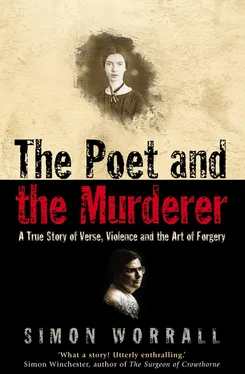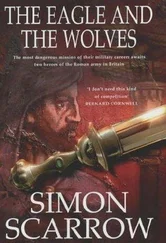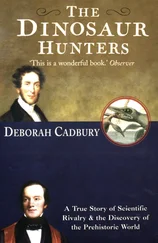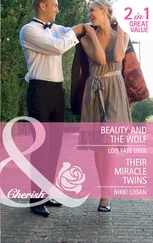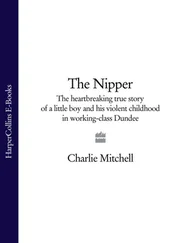1 ...6 7 8 10 11 12 ...16 There were also two forms of the letter e . One looked like the number three, written back-to-front. It appears, capitalized, at the beginning of the word Everyone , in the third line of the poem, and in the signature, ‘Emily.’ The same unusual form also appears in lowercase in the word solace . Other words in the poem contained a more usual form of the letter. Franklin’s charts showed him that, in 1871, Dickinson was using both forms.
Even the way the sheet of paper was folded conformed to the way Dickinson had sent her poems. At this time Dickinson generally folded her letters in thirds. The fact that two thirds of the left-hand sheet of the bifolia on which the poem was written was missing suggested that there had been wear in those places, and that eventually the page had been torn away.
Despite these minute details suggestive of authenticity, Franklin had a number of questions. He asked the Gallery of History to fax him the measurements of the manuscript, in millimeters, across the fold and along the top. He also asked for detailed provenance information and how the Gallery of History had dated the poem to 1871. Out of curiosity he also asked the price.
He was out when the Gallery of History called him back, but the information his assistant relayed to him further confirmed that the poem was genuine. They were unwilling to release any information on the poem’s provenance. But Franklin knew that, in the rare-documents business, such discretion was not uncommon. Many owners do not like to release their names, for fear of publicity or for tax reasons. And the measurements were exactly right. As far as the 1871 date was concerned, the Gallery of History claimed that they had dated the poem based on research done on the boss mark on the paper by a scholar named Elizabeth Witherell. This surprised Franklin, because Witherell was a Thoreau scholar, not a Dickinson scholar. But, who knows, thought Franklin, perhaps Witherell had a large supply of nineteenth-century paper. In fact, Witherell had never seen the poem.
The price of the poem was $45,000. There had never been any discussion of Franklin doing an authentication, so when, during one of their conversations, Tammy Kahrs asked him if he would mind if they used his name when they sold the poem, he was flabbergasted. As far as he was concerned, he had supplied the Gallery of History with general information about the poem’s possible historical context and his view of the handwriting. But he had not given any opinion as to its authenticity.
Despite the slight uneasiness caused by this incident, and the lack of provenance information, Franklin felt sure enough that the poem was genuine that he made tentative plans to include it in his new edition. There were some minor copyright issues – the fax from the Gallery of History came with a standard disclaimer prohibiting the distribution or copying of all communications – but he would deal with those later, closer to publication, which had tentatively been set for 1997. He thought nothing more of the matter until he saw the poem in the Sotheby’s catalog in May of that year.
Franklin was on vacation in Switzerland when Brent Ashworth called him from Salt Lake City. Franklin knew Ashworth because he had conferred with him about a previous Dickinson poem that Ashworth had bought, and he regarded Ashworth as a reliable source of information. Ashworth told Franklin what he had told Lombardo: that he had been offered the poem by Mark Hofmann in 1985, and that he believed it was a forgery.
Like everyone in the historical documents trade Franklin knew Hofmann’s reputation. Shattering as it was, though, the news did not definitively prove the poem was a forgery. After all, it was well known that Hofmann had also handled genuine manuscripts. But when Ashworth told him that he had subsequently seen the poem in one of the Gallery of History’s boutique stores, Franklin’s heart skipped a beat. If it were true, he realized that he might have unwittingly become involved in a chain of illicit transactions that stretched from a murderer in Salt Lake City to a historical documents dealer in Las Vegas, and then onto him. It was not the sort of company a distinguished scholar at Yale University was used to keeping.
Franklin also knew from bitter experience the damage a forgery can wreak on the lives of people involved in the rare manuscript world. He had seen friends and colleagues tear each other apart over one of the twentieth century’s most celebrated fakes: the Vinland Map. The map, which resides at the Beinecke Library, surfaced in 1957 in clouded circumstances. It purported to be the original map used by Leif Eriksson on his voyage of discovery to the New World. Scholars took sides for or against its authenticity. Even after forensic tests revealed that, in a crude attempt to simulate age, the forger had put yellow-brown ink underneath the map’s black ink outlines, controversy continued to rage, leading to bitter divisions among friends and colleagues that will never be resolved.
It seemed to Franklin that he might have become entangled in an even more sensational case of forgery: a forgery that had homicide as one of its components. Not only was Franklin’s reputation as the foremost expert on Emily Dickinson’s handwriting at stake, but also his position as one of Sotheby’s most important customers. According to Ashworth, when he had called Sotheby’s to warn them about the poem, they had named Franklin as one of the ‘experts’ who had vetted the poem. If that were true, it would be a grievous breach of professional trust. Franklin had not authenticated the poem for Sotheby’s. Indeed, he had had no formal contact of any kind with them prior to the auction.
As Franklin puzzled over what to do, an event that had occurred at the end of May, only days before the poem was auctioned at Sotheby’s, took on new significance. Franklin had traveled down from New Haven to New York to look at the poem during the public preview. These public previews take place a few days before an auction, and give dealers and collectors a chance to study the books and manuscripts they are thinking of bidding on. To study manuscripts Franklin uses a ‘linen tester’: a powerful magnifying glass used by textile merchants to assess the quality of linen. So, having removed the poem from the glass case in which it was being displayed, Franklin set it down on a table and examined it. Up until now he had only seen a faxed copy of the poem. But with the original in front of him he was able to study the paper and handwriting with far greater accuracy. Everything tallied, as he expected it would, as far as the writing was concerned. He now turned his linen tester to the embossing in the top left-hand corner. Under magnification he could see quite clearly that this was, indeed, one of two kinds of Congress paper that Emily Dickinson had used in the 1870s.
While he was studying the boss mark, a Sotheby’s employee he knew came up and engaged him in conversation. ‘It was mostly small talk,’ Franklin said, ‘but I suppose that they could have interpreted from that conversation that I thought the poem was genuine.’ Was this what they had meant when they told Ashworth that the poem had been ‘checked out’ by Ralph Franklin? That he had seen it at the public preview and not voiced doubts about it? If so, it would be a cynical misuse of his reputation. For Sotheby’s and the other auction houses know that the scholars and experts who come to their public exhibitions never opine on a document or a painting (unless it is to say something affirmative) for fear that, at a later date, an irate collector may sue them.
When he had first seen the poem, he had studied it for signs of authenticity. Galvanized by Ashworth’s call, Franklin now began to look at it from the opposite point of view. ‘I kept looking and looking for what would show a forger’s hand,’ he said, ‘and I finally came up with a few anomalies. One of them is the capital T in the first word of the poem. Normally it slants down in Dickinson. And these T ’s do not slant down.’
Читать дальше
